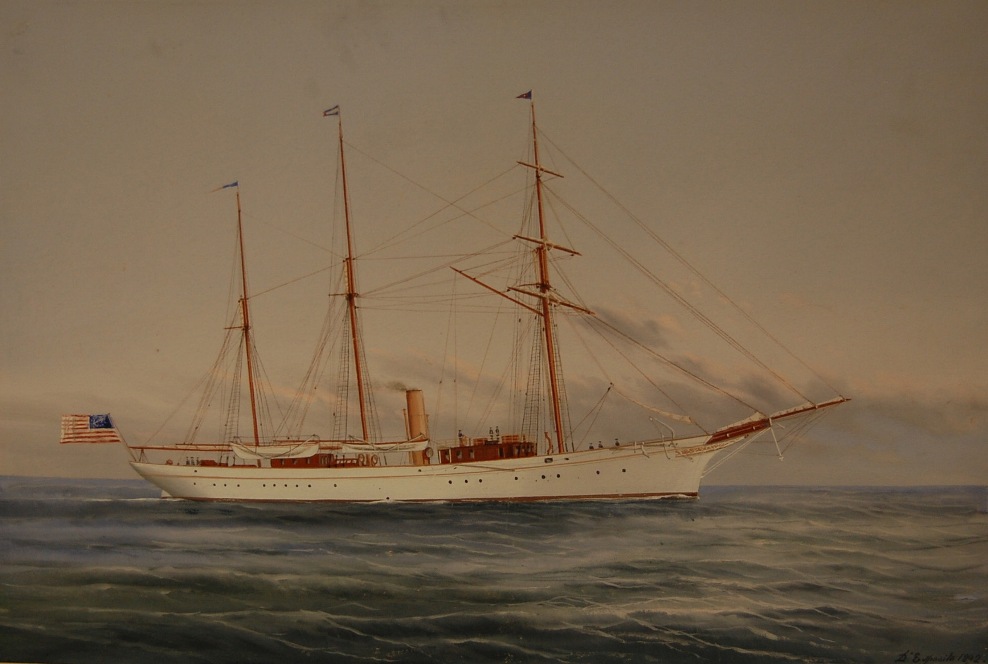By Vivian Zoë for Connecticut Explored
The Grand Tour, a tradition under which young men of means had since the 17th century extended their education by touring Europe, became popular in America in the late 1800s and was passionately embraced by Connecticut residents of affluence and cultivation. In 1867, Mark Twain (who would move to Connecticut in 1872), reported on his own Grand Tour for the San Francisco newspaper Alta California. Twain later turned his dispatches into the 1869 book The Innocents Abroad, or the New Pilgrim’s Progress. With more than 70,000 copies sold in its first year, it remained the best selling of Twain’s books throughout his lifetime.
A quarter century after Twain’s tour, William and Ellen Slater of Norwich followed an almost identical route onboard their 232-foot yacht Eleanor. The descriptions written by young crew member Charles Taylor Bright of Plantsville in his letters home and First Officer Eugene W. Johnson in the ship’s logbook barely differ from Twain’s descriptions of the same ports of call. No written account by the Slaters has been found, but a two-volume photograph album documenting their trip exists.
The Slaters
William A. Slater was born in 1857 in Norwich. His wealth had been established generations earlier in the textile industry, and he skillfully increased it. So flush was he that, only eight years after he spent $100,000 to build Norwich Free Academy’s Slater Memorial Building to house a museum in honor of his father, William paid $300,000 (more than $7.5 million in today’s dollars) for a yacht he named after his daughter, the Eleanor.
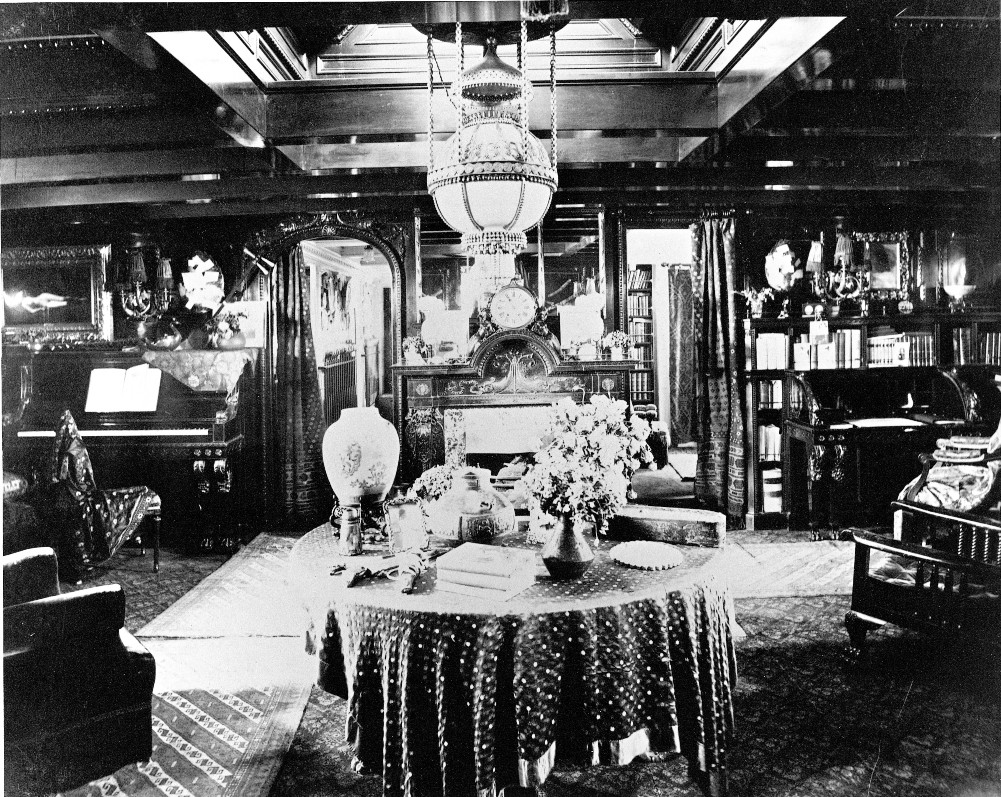
The saloon of the Eleanor – Slater Memorial Museum
The Bath Iron Works in Bath, Maine, built the vessel in 1893-1894. The New York design firm of Tiffany & Co. designed the ship’s elegant staterooms trimmed in rare woods; Persian rugs covered the floors, and oil paintings hung on the walls. Cold and hot water, both salt and fresh, ran from taps in the private bathrooms. The ship had a laundry, a library with hundreds of titles, and a fireplace in the “saloon.” The Day of New London, Norwich Bulletin, and Bath newspapers reported regularly on the luxurious details and amenities of the Eleanor while she was still under construction. Builders enlisted the Colt Armory to install on the deck three Gatling guns capable of firing 800 rounds per minute to deter pirates. Before leaving New London in October 1894, the crew loaded 75 cases of champagne.
Traveling Around the World
The Slaters, then in their late 30s, planned a 17-month round-the-world tour, traveling with their children Eleanor, age 9, and William, age 5, other family, friends, and various attendants, numbering nearly a dozen in all. They planned to stop in the Azores, Marseilles, France, Naples and Sicily, proceed through the Suez Canal to Egypt, Bombay, Hong Kong, and Nagasaki, Japan, with several month-long stops for land travel in France, Egypt, and India.
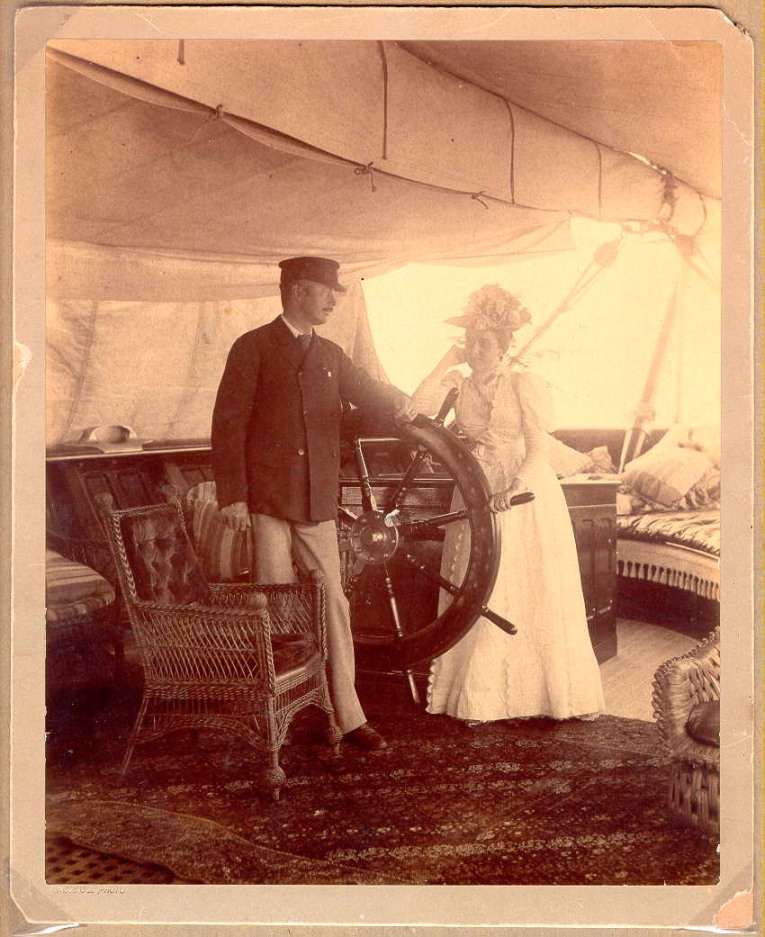
William and Ellen Slater on the Eleanor during their 17-month sail around the world, 1894-1895 – Slater Memorial Museum
William Slater was educated in one of the first classes at the Norwich Free Academy and at Harvard, graduating in 1881. He had studied under the noted art historian Charles Eliot Norton, had traveled extensively before this Grand Tour and had been exposed to the work of many emerging artists. He and Ellen owned an extensive collection of French paintings and preferred the work of the Barbizon School painters, named for the small town in France in which the artists found inspiration. The couple began lending paintings from their collection to the Slater Museum as early as two years after its founding.
By the time the Eleanor reached Marseilles, Captain Charles W. Scott had taken ill, so in addition to needing time to re-paint the yacht (First Officer Johnson reported that already the “poor old ship is black from stem to stern” from the coal smoke) and rebuild its galley to satisfy the chef, all awaited the captain’s recovery. Young Bright was happy since he only had to work six or seven hours each day while in port. His happiness was tempered, however, by the fact that the crew had not yet been paid, making the temptations of southern France inaccessible.
From Marseilles, the Eleanor sailed to Cannes, Naples, Messina, and on to the Suez Canal. Before visiting Pompeii and Sicily, according to Johnson’s log, on December 24, 1894:
Several of the party went over to Pisa. The ride, some fifteen miles was over a rough road. The snow capped Apennines being ever in view. Extensive vineyards were to be seen … The town of Pisa is uninteresting but the tower repays one for the drive [by carriage or wagon] which today was frightfully cold. The tower is one hundred and eighty-three feet high and thirteen feet out of perpendicular.
In a letter to his mother in Bridgeport, Bright described the Suez Canal as “. . . built through a desert and there was a sand storm. It is a very big peace [sic] of work. We could only run five miles a hour so not to make a swell as the sides are sand and would fill up very fast with so many vessels going through. We seen a carrivan with two camels and one mule and four men traveling through the desert.”
Egypt must have appeared to Bright and the Slaters notably foreign and exotic in culture, climate, geography, and economy. We know Johnson was enthralled with Cairo: He gushed:
To a traveler from the west everything is novel and has an interest—pyramids, mosques, museums, bazaar etc. but above all the street scenes. It is difficult to imagine anything more varied or pretty than the procession continually passing before Shepheards Hotel on up and down the Gezirah Drive—Arabs in their flowing robes of blue, black on white. Peasants with their laden camels and donkeys well dressed Egyptians and veiled ladies in carriages with gorgeously dressed footmen…
Orientalism in the Late 19th Century
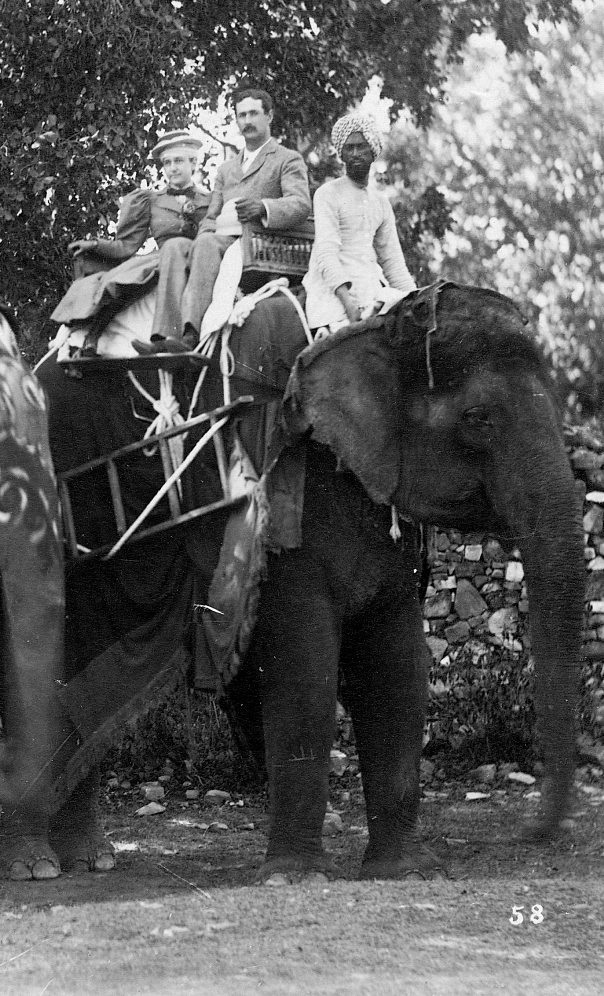
William and Ellen on an elephant, India – Slater Memorial Museum
Both Twain and the Slaters were riding a tide of American, European, and British fascination with all things Egyptian. Fueled by the Orientalist paintings of Jean-Auguste-Dominique Ingres, Eugène Délacroix, and Jean-Léon Gérôme, among others, the wide availability of photographs beginning in 1860, magazine articles, and books, Grand Tourists streamed into Egypt in the late 19th and early 20th centuries. The Slaters had many professional photographs taken of themselves; while in Egypt, they were photographed participating in “touristy” activities such as riding a camel—all while dressed in layered, corseted, dark Victorian daywear.
Arriving at Bombay (now Mumbai), India, on January 28, 1895, Bright marveled that
It is just like a Summer night at home. we are at sea at the full of the moon. And talk about moon light excursions at home the night here beats them all out. The only thing lacking is a nice young Lady to chat with. But the boys get to gether and sing and play till about eleven o’clock. We will not travel so fast after this as Mr Slater brother in law [Frances Bartlett] lives here and he has been with us ever sence we arrived in Leghorn [Livorno, Tuscany]. …Mrs Slater… likes to put on a lot of style with the English navel officers every English and American man of war ship in the harbors. They give Suppers to So you see they are putting lots of style…The Party come on board Tuesday morning so thing are very strick [sic] every evening that we go on deck it is dress in white.
Bombay in 1895 was under British rule. Its cotton industry prospered during the American Civil War, and considerable resources were invested in rebuilding the city’s core into an elegant 19th-century city on an archipelago of islands. Though the standard of living in Bombay was high, labor for the cotton factories came from poor rural regions of the country. Workers were segregated into crowded and poor living quarters and huge squalid slums developed. It is unclear whether the Slaters or Bartlett had business interests in the local textile industry, but they benefited from the high standard of living at low cost available to those who brought American or British money into the country.
Royalty Entertains the Slaters
Johnson recorded in the ship’s log (which was sometimes later corrected by Mrs. Slater) where in each port and major city the Slaters hosted or were hosted by royalty or important officials. On March 28, 1895, in Singapore, “Mr. Slater called on Sir Charles Mitchell, Governor of the Straits Settlements. Mrs. Slater attended the reception of a wealthy and progressive Chinaman Seah Leang Seah at his Place Baudelaire and in evening Mrs. Slater and guests dined with Mr. Pratt the American Consul.” And on March 30,
At quarter before six with Mr. Pratt and Captain Crawford aboard started for Phon where we arrived soon after ten. The party…lunched with the Sultan. Phon is a small town, the only sight really is the gambling establishment which is very large and is frequented chiefly by Chinese…The Crown Prince who is still quite young came aboard in afternoon. Lord Caine and two friends returned on the yacht to Singapore where we arrived at dark. Later Mr. and Mrs. Slater and guests dined at Government House.
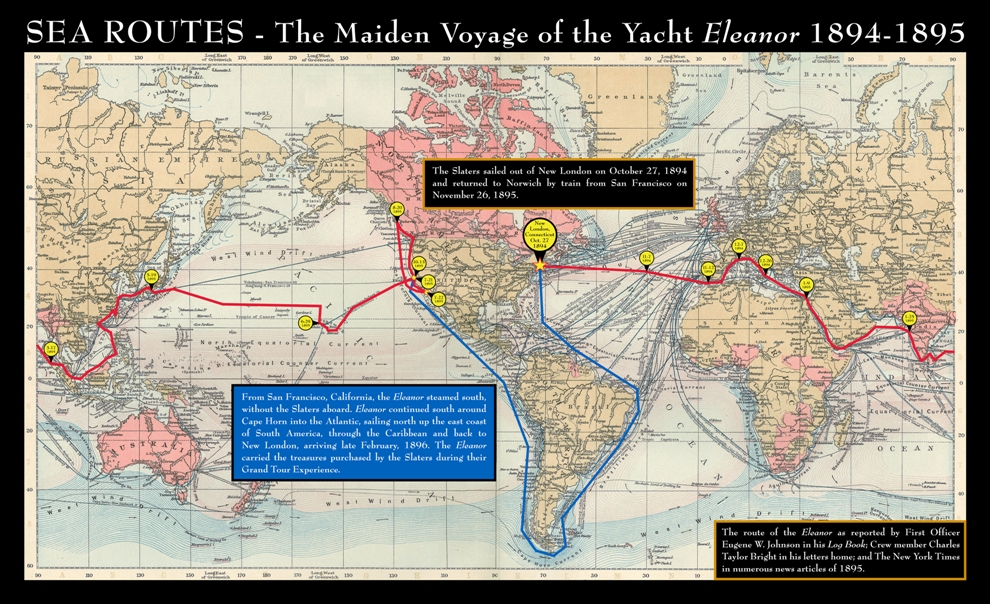
Map of the Maiden Voyage of the yacht Eleanor, 1894-1895 – Slater Memorial Museum
Arriving in Japan
By five in the morning on May 2, 1895, the Eleanor was underway, bound for Nagasaki. She passed into the Yangtze-kiang. First Officer Johnson reported “Rain has fallen most of the day and it has been cold and dreary on the deck, but within the fires have blazed cheerily in the grates and we have missed none of the comforts of home… .” On May 3, 1895, he wrote, “Anchored in Nagasaki harbor about half past seven in evening after a good day’s run: in fact the run from noon to noon was the best yet recorded.”
The Slaters sailed from Japan to Honolulu in the Sandwich Islands (now Hawaii), to what is now Alaska and back to the southern Pacific. They returned by train on November 2, 1895, from California to Connecticut, arriving first in New York, then by carriage home. Bright became disillusioned with the Eleanor for reasons that are not clear and left the yacht upon its arrival in San Francisco. Captain Scott and First Officer Johnson sailed the yacht from there through the Strait of Magellan and the Atlantic and home to New London.
Further Voyages of the Eleanor
The Eleanor went on to have many more adventures. With William in ill health and Ellen tired of life at sea, the Slaters in 1900 sold the yacht to Mrs. James Martinez-Cardeza of New York, who took her on her own Grand Tour. Later owners included railroad magnate James J. Hill, who renamed her Wacouta and used her for recreational salmon fishing on the Great Lakes, and George F. Baker, Jr., for whom the Baker Business Library at Harvard is named. In 1918 Baker gave her to the US Navy. She was renamed Harvard to serve as a convoy escort during World War I and conveyed relief supplies after the war. She participated in at least one dramatic rescue during the war and remained in commercial service at least until the late 1940s.
Vivian Zoë is director of the Slater Memorial Museum in Norwich.
© Connecticut Explored. All rights reserved. This article originally appeared in Connecticut Explored (formerly Hog River Journal) Vol. 10/ No. 1, WINTER 2011/2012.
Note: ConnecticutHistory.org does not edit content originally published on another platform and therefore does not update any instances of outdated content or language.





